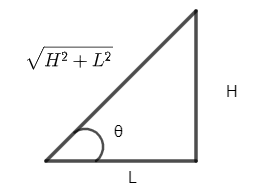
A hunter tries to hunt a monkey with a small, very poisonous arrow, blown from a pipe with initial speed v. The monkey is hanging on a branch of a tree at height H above the ground. The hunter is at a distance L from the bottom of the tree. The monkey sees the arrow leaving the blowpipe and immediately loses the grip on the tree, falling freely down with zero initial velocity. The minimum initial speed v of the arrow for hunter to succeed while monkey is in air:
A. $\sqrt {\dfrac{{g({H^2} + {L^2})}}{{2H}}} \\ $
B. $\sqrt {\dfrac{{g({H^2} + {L^2})}}{H}} \\ $
C. $\sqrt {\dfrac{{g{H^2}}}{{\sqrt {{H^2} + {L^2}} }}} \\ $
D. $\sqrt {\dfrac{{2g{H^2}}}{{\sqrt {{H^2} + {L^2}} }}} $
Answer
219k+ views
Hint:In order to solve this question, we will use the formula of maximum height and range for a projectile motion and form a relation between height and range with initial speed and then we will solve for minimum initial speed of the arrow.
Formula used:
For a projectile motion range R is given by,
$R = \dfrac{{{u^2}\sin 2\theta }}{g}$
And height H is given by,
$H = \dfrac{{{u^2}{{\sin }^2}\theta }}{{2g}}$
where u is initial velocity and $\theta $ is angle of projection.
Complete step by step solution:
According to the question, let initial velocity of the arrow is u and angle of projection is $\theta $ so distance L is given by using,
$R = \dfrac{{{u^2}\sin 2\theta }}{g}$
We have
$L = \dfrac{{{u^2}\sin 2\theta }}{g} \to (i)$
And height H is given by using,
$H = \dfrac{{{u^2}{{\sin }^2}\theta }}{{2g}}$
We get,
$H = \dfrac{{{u^2}{{\sin }^2}\theta }}{{2g}} \to (ii)$
Divide equation (ii) by (i) we get,
$\dfrac{H}{L} = \tan \theta $
So from the right angle triangle we have,

$\sin \theta = \dfrac{H}{{\sqrt {{H^2} + {L^2}} }} \\ $
Now, put this value in equation (ii) we get
$H = \dfrac{{{u^2}{{(\dfrac{H}{{\sqrt {{H^2} + {L^2}} }})}^2}}}{{2g}} \\
\therefore u = \sqrt {\dfrac{{g({H^2} + {L^2})}}{{2H}}} \\ $
Hence, the correct answer is option A.
Note: It should be remembered that, the basic trigonometric ratios are related as $\tan \theta $ is ratio of opposite side to adjacent side whereas sine of angle is the ratio of opposite side to hypotenuse side of the right angle triangle.
Formula used:
For a projectile motion range R is given by,
$R = \dfrac{{{u^2}\sin 2\theta }}{g}$
And height H is given by,
$H = \dfrac{{{u^2}{{\sin }^2}\theta }}{{2g}}$
where u is initial velocity and $\theta $ is angle of projection.
Complete step by step solution:
According to the question, let initial velocity of the arrow is u and angle of projection is $\theta $ so distance L is given by using,
$R = \dfrac{{{u^2}\sin 2\theta }}{g}$
We have
$L = \dfrac{{{u^2}\sin 2\theta }}{g} \to (i)$
And height H is given by using,
$H = \dfrac{{{u^2}{{\sin }^2}\theta }}{{2g}}$
We get,
$H = \dfrac{{{u^2}{{\sin }^2}\theta }}{{2g}} \to (ii)$
Divide equation (ii) by (i) we get,
$\dfrac{H}{L} = \tan \theta $
So from the right angle triangle we have,

$\sin \theta = \dfrac{H}{{\sqrt {{H^2} + {L^2}} }} \\ $
Now, put this value in equation (ii) we get
$H = \dfrac{{{u^2}{{(\dfrac{H}{{\sqrt {{H^2} + {L^2}} }})}^2}}}{{2g}} \\
\therefore u = \sqrt {\dfrac{{g({H^2} + {L^2})}}{{2H}}} \\ $
Hence, the correct answer is option A.
Note: It should be remembered that, the basic trigonometric ratios are related as $\tan \theta $ is ratio of opposite side to adjacent side whereas sine of angle is the ratio of opposite side to hypotenuse side of the right angle triangle.
Recently Updated Pages
Two discs which are rotating about their respective class 11 physics JEE_Main

A ladder rests against a frictionless vertical wall class 11 physics JEE_Main

Two simple pendulums of lengths 1 m and 16 m respectively class 11 physics JEE_Main

The slopes of isothermal and adiabatic curves are related class 11 physics JEE_Main

A trolly falling freely on an inclined plane as shown class 11 physics JEE_Main

The masses M1 and M2M2 M1 are released from rest Using class 11 physics JEE_Main

Trending doubts
JEE Main 2026: Application Form Open, Exam Dates, Syllabus, Eligibility & Question Papers

Understanding Uniform Acceleration in Physics

Derivation of Equation of Trajectory Explained for Students

Hybridisation in Chemistry – Concept, Types & Applications

Understanding the Angle of Deviation in a Prism

Understanding Collisions: Types and Examples for Students

Other Pages
JEE Advanced Marks vs Ranks 2025: Understanding Category-wise Qualifying Marks and Previous Year Cut-offs

Units And Measurements Class 11 Physics Chapter 1 CBSE Notes - 2025-26

NCERT Solutions For Class 11 Physics Chapter 8 Mechanical Properties Of Solids

Motion in a Straight Line Class 11 Physics Chapter 2 CBSE Notes - 2025-26

NCERT Solutions for Class 11 Physics Chapter 7 Gravitation 2025-26

Understanding Atomic Structure for Beginners




